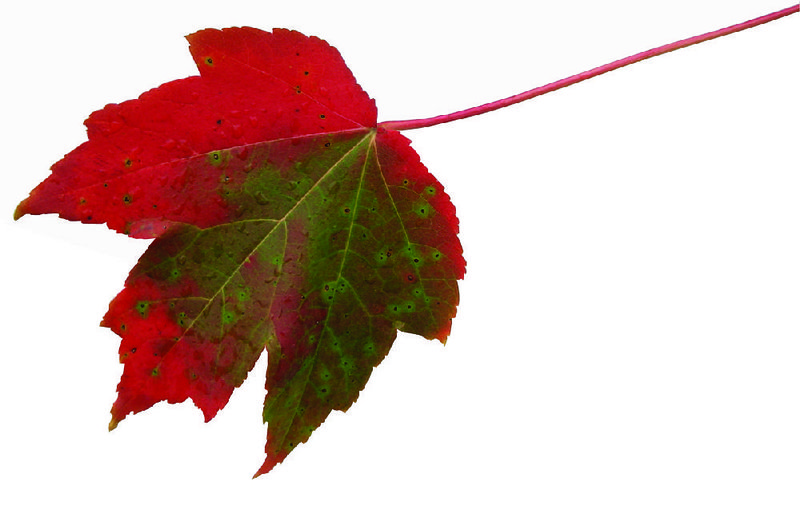Arkansas Parks and Tourism's weekly fall color updates have told a disappointing tale this year, although there were some bright spots.
Excerpts from Nov. 5's online forecast on the progress of fall color through three regions of the state:
• Ozarks (north-central and Northwest Arkansas): "Color change in the Harrison area is sparse this week. Many trees have either lost or are losing their leaves and the peak in this region is believed to have passed. In the Fort Smith area ... oaks are beginning to turn orange, but some have gone straight to brown."
• Ouachitas (west-central Arkansas): "At Lake Catherine State Park fall colors are reported to be at their peak. A color change is still expected among the post oaks and red oaks. The recent rains in the area have caused approximately 20 percent of the leaves in the park to fall. ..."
• Delta: "In Helena-West Helena, not much more of a color change occurred since the previous week. Many leaves are turning brown and dropping. At Village Creek State Park, about 90 percent of the foliage has either changed or fallen, and many leaves were lost during the rain. ..."
Typically, according to arkansas.com, color in the Ozark Mountains peaks in late October to early November; the western and central part of the state, which includes the Ouachita Mountains and the Arkansas River Valley, usually peak in early to mid-November; and the southern (Gulf Coastal Plain) and eastern third, which includes the Delta, transforms by mid-November.
Autumn's annual palette in Arkansas is an ever-changing offering with no two years exactly the same. Yes, there are usually browns, reds, oranges, yellows and greens to behold. But at what level and intensity? When the foliage isn't vibrant or the vibrancy fades quickly, it does have an impact on tourism, said Joe David Rice, the state's tourism director.
"You never know what Mother Nature is going to do, and you have to be honest with the folks who call and want to know what kind of season we're expecting," Rice said.
Although rainfall broke the summer's statewide drought in time to prevent a totally drab autumn, the colors "still didn't meet our expectations," Rice said Nov. 2. "We're trying to put together some photos for a new coffee table book we're working on and found it's a little better but still isn't that great."
He blames the lackluster leaves on the long-term drought. "And the big rain we finally got in late October didn't make it to Northwest Arkansas," he said.
Rice says the changing fall colors are an important component of the state's tourism industry, especially for places like Eureka Springs, Harrison and communities along the Northwest Arkansas Pig Trail. These areas are replete with potentially colorful foliage such as hickory and maple trees.
As an example, he estimates the ebb and flow of tourists who sought lodging in Northwest Arkansas based on collections of the tourism tax in Carroll County in fall 2014: $3.5 million that September, $3.8 million in October and $2.3 million that November. "The October collections were about 10 percent above those in September and considerably greater than those in November," Rice said.
Instead of dwelling on this year's colors, "we're just going to hope that Mother Nature treats us a little bit kinder next year," he says.
Meanwhile, those whose businesses rely on a scenic fall foliage lose customers when the show isn't at its prime.
Lee McAhren of Spring-dale owns Arkansas Helicopters LLC with her husband, Cameron. Some of the couple's business comes from those wanting an aerial view of the changing colors in the fall. Their fall foliage flights are offered, by appointment only, through Nov. 24.
"We haven't seen much of a decrease in the number of people interested in viewing the foliage this year but it is going be a shorter season," McAhren said Nov. 2. The couple offer a Beaver Lake fall foliage flight. Their by-appointment-only outings include a 10-minute flight for up to three passengers for $150 plus tax; a 20-minute flight for $300; and a 40-minute trip toward Winslow over the Ozark Mountains for $600.
McAhren said she saw good colors but, like others, concluded that the long-term drought appeared to have shortened this year's viewing season.
The less-than-brilliant hues haven't dismayed tourists who chose to see the changing colors via rail.
Brenda Rouse, passenger train operations manager for Arkansas & Missouri Railroad, a Springdale-based railroad that operates a passenger excursion train between that city and Van Buren, says the railroad carried more than 3,500 riders in October, compared to 3,000 for that same month in 2014.
The railroad works in partnership with the Department of Parks and Tourism, and many passengers are visitors from out of state who come with tour groups. Instead of booking a round-trip, most of these groups choose the one-way option so they can see other sights in the destination city, Rouse said.
"The colors really haven't been as great this year as last year, but this past week alone we had more than five buses of tour groups coming through," Rouse said the first week of November.
The Department of Parks and Tourism posts its updates at arkansas.com by 5 p.m. each Thursday and includes rough estimates of how much the canopy has changed or dropped, and which species of trees are still transforming. (The website also has a list of family friendly events as well as festivals, photos, and directions to eight suggested scenic driving routes. They include Crowley's Ridge Parkway National Scenic Byway, the Great River Road National Scenic Byway, and the Boston Mountains Scenic Loop/U.S. 71 and Interstate 540.)
ActiveStyle on 11/16/2015
